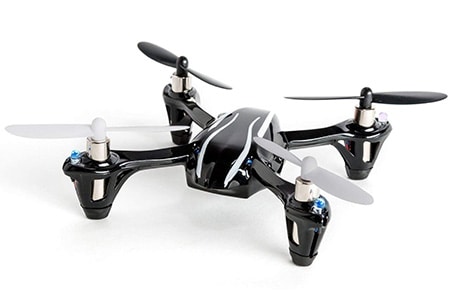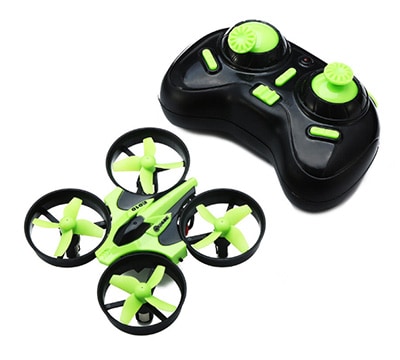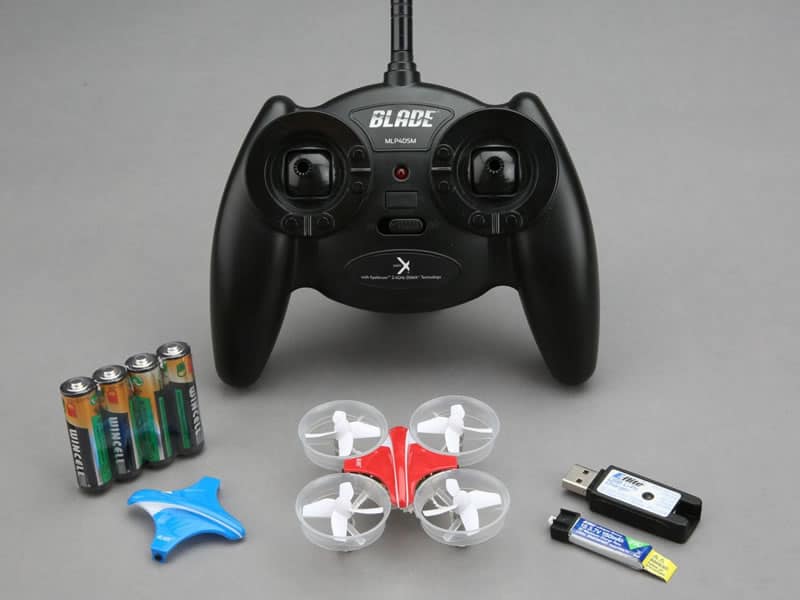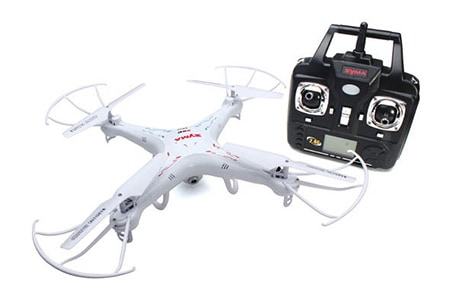Whenever I am out flying, I mostly get asked three questions:
- How high does this thing go?
- How much did it cost?
- Where can I get one?
And while the answers to the first two questions may vary, the last question is incredibly important – where can I get one?
A better way to rephrase that question would be which is the best quadcopter for beginners?
Note: The first part of the post is about setting expectations and knowing what you’re getting into. The second part will be recommendations on beginner quadcopters. I strongly recommend you read the post from start to finish.
Flying quadcopters does not come naturally, unfortunately, and the first few times flying will feel incredibly strange. So before you invest in a large hobby-grade quadcopter that costs upwards of $1000, it’s better to get a smaller quadcopter first that you can practice on and get comfortable flying.
From what I’ve seen being in the hobby for over a year now, far too many people start out with a large, powerful quadcopter and have trouble controlling it, or end up flying it where they shouldn’t be flying it.
The fact of the matter is that large quadcopters are incredibly powerful. They have 4 large(the DJI Phantom for example has 10 inch propellers) blades spinning at several thousand RPM, and they’re no joke, especially if you are unsure of what you are doing.
You may be wondering why I am ranting on and on about how big copters are a lot to handle – but honestly, I could not be ranting enough – this is the most important lesson to learn before you get into the hobby! So unless and until you are comfortable with how a quadcopter flies and works, you’re endangering yourself and your surroundings by biting off more than you can chew.
Not to mention you are risking your $1000 every time you go out to fly!
Luckily, the situation is not as dire as it would seem.
You can easily get the hang of flying quadcopters on a small beginner quadcopter, then immediately upgrade to something bigger.
Note: If you’re looking specifically for indoor drones, check out this post
Advantages of toy quadcopters
- Cost: Toy quadcopters – at least the ones I’m listing here – all cost less than $150 and won’t take as much of a bite out of your wallet if you crash/lose it. For the cost of one whole hobby-grade racer, you can go through nearly 30-40 toy quadcopters! Not that you would need to…
- Size: These small copters can usually fit within the palm of your hand, making them much more maneuverable and forgiving if you make a mistake. You can also learn to fly them in relatively smaller spaces.
- Weight: Toy quadcopters are also much lighter than larger quadcopters. A toy quadcopter will typically weigh less than 50 grams. A 210mm sized racer weighs 400-500 grams on average, and a DJI phantom weighs nearly 1.5 kilograms!
- Durability: The smaller size and weight of the beginner quadcopters means they will not break as easily when you crash. Larger quadcopters weigh more and have more inertia, so smaller crashes will do significantly more damage, both to what they crash into and themselves.
How long will it take to learn?
There is no one-size-fits-all answer to this, sadly. But putting in a decent amount of practice every day for a few weeks or a month will get you comfortable enough to start flying larger quadcopters.
Flying and crashing the smaller machines will also give you a good idea of repairing, emergency maneuvering, and safety – all crucial lessons you can apply to flying larger machines.
So whether you wish to get into aerial photography, or drone racing, the best place to start is and will always be a toy quadcopter.
Setting expectations and learning to fly
Flying a quadcopter
Flying a quadcopter will be like nothing you have ever done before, unless you have experience flying rc helicopters or rc planes.
The quadcopter will respond to very slight movements on the remote control’s sticks, so if you mash the sticks, you will crash. If you’re used to flying planes or helicopters, you’ll have some level of comfort on the sticks – and you’ll know not to mash the sticks/push them too far to get results.
You’ll also need to practice adjusting all four axes at once – so you’ll be making adjustments to both sticks along both of their axes(up/down and left/right) in order to fly properly.
When you start out, don’t worry too much about controlling all four axes at once as it may be overwhelming. Start out by just practicing with the throttle and trying to keep the quadcopter in a stable hover. Don’t even worry if the quadcopter is drifting around, just try and maintain a particular altitude.
You’ll notice that you’ll have to keep moving the throttle stick up and down very slightly in order to achieve this.
Next, you can attempt to keep the quadcopter in one spot by using the right stick to control the quadcopter’s tilt.
Finally, you can try coordinated turns by introducing yaw(turning the quadcopter’s nose left and right). How to use the sticks is very difficult to explain by only text, so I’d recommend you watch this excellent video on how to get started with flying:
For more flying tips, check out my post on getting started with fpv drone racing.
Crashing and repairing
A toy quadcopter is a good place to get used to the fact that you will crash. A lot. And you’ll also be repairing. A lot. You’ll be replacing propellers, motors, and maybe even the whole frame – but that’s all part and parcel of the hobby.
As you get more adventurous, you can even start doing mods on your gear to make it fly differently. A quick google search for your model + mods will bring up a whole host of options you can try out.
Practice, practice, practice
A couple of weeks to a month of regular practice and pushing yourself will get you used to the quadcopter and you’ll be a professional in no time – in a manner of speaking. Set aside 30 minutes to an hour per day(this will be a lot more once you’ve graduated to larger quadcopters) for practicing.
Most quadcopters only come with one battery, so you’ll want to get some spare batteries to stay in the air for longer. One battery will last 3-5 minutes depending on how hard you fly and what model you are flying, and most of the USB chargers that come with these quadcopters take about 40-50 minutes to charge it up.
Flyaways
These quadcopters are small, so do not test to see how far they can fly! Only fly as far away as you’d be willing to go and pick it up off the ground in a crash!
Also, do not test how high they can go! These machines weigh very little and a small gust of wind can blow it out of sight. Stick to flying low – 20-30 feet at the most, and flying it near you – no more than 50-100 feet away.
In the multirotor hobby world, there is a thing called a “walk of shame” – walking over to pick up your quadcopter after a crash. Only fly as far as you’re willing to walk!
Still, be prepared for a malfunction(although highly unlikely) where your quad may stop responding and decide to fly away on its own. Again, this is why you get a $40 quadcopter instead of a $1000 one first! Flyaways won’t damage your wallet as much.
If you are the unfortunate victim of a flyaway, don’t fret. If you feel you are enjoying the hobby, go get another one!
Don’t worry about cameras
I don’t suggest you consider a camera as a must-have feature for your first quadcopter. The video quality on the toy quadcopters really sucks, and it’s just an extra $10-20 you will be unnecessarily spending. Focus on mastering flying first, then go ahead and invest in a larger platform that carries an HD camera.
My picks for the best quadcopter for beginners
With all of that out of the way, here are my top choices for beginner quadcopters:
1. Hubsan X4
The Hubsan X4 is my toy quadcopter of choice and the one I recommend to everyone who is looking to get into the hobby. It’s small, moderately powerful, light, and best of all, cheap. Since Hubsan is a Chinese brand, their products are a little cheaper than similar US-based brands.
There are two flight modes in the Hubsan X4 – beginner and advanced. In beginner mode, the quadcopter will only tilt a certain number of degrees even if you push the sticks all the way. These are good training wheels for getting used to the sticks on your first few flights.
As you get more comfortable, you can move onto expert mode, where the quadcopter will tilt much more, and much faster, too. This will let you do more rapid maneuvers.
The Hubsan is a very popular quadcopter so spare parts are readily available, cheap, and there is a wealth of information to be found on the internet from other users.
Check Price at Banggood
Check Price at Amazon
2. Eachine E010
The Eachine E010 is a super tiny quadcopter that still packs a lot of punch. It’s propellers are ducted, so you can bump into anything and not damage your props or whatever you are bumping in to.
Since of it’s price, It can not be bound to any Spektrum/DSM compatible radio – so when you upgrade your gear and invest in a good radio, you may need to buy a new one.
It has multiple flight modes like the Hubsan X4 and a very tiny stock transmitter which people with large hands may find difficult to use. But still, for $15, you can’t really go wrong.
Check Price at Banggood
Check Price at Amazon
3. Blade Inductrix
The Blade Inductrix is kind of an upgraded Eachine E010, including all of it’s feature plus more.
The Blade Inductrix is more expensive than the Eachine E010, but that’s because it can be bound to any Spektrum/DSM compatible radio – so when you upgrade your gear and invest in a good radio, you can use your radio with your Inductrix. The stock transmitter(radio) is pretty mediocre.
This quadcopter have unlimited upgrade potential thanks to the “Tiny Whoop” revolution, where you add FPV gear to this quadcopter and turn it into indoor FPV madness machine – a great way to keep using the quadcopter even as you upgrade your skills and gear.
Check Price at Amazon
4. Syma X5C
The Syma X5C is another great beginner quadcopter. As far as basic features go, they are the same as the Hubsan X4 or the Blade Inductrix. However, the Syma X5C is a much larger quadcopter than the other two mentioned above, so it will have more power(thanks to larger propellers) and it can perform much better outdoors.
Its size will probably mean you can’t fly indoors though, unless you have access to a large gymnasium or hall.
The Syma X5C is also equipped with a camera which takes half decent photos. I know I mentioned above that cameras don’t really matter, and the same can be said for the Syma camera – it’s more of a gimmick than something you can take actual photos with. Still, it’s a decent novelty.
I’m recommending the Syma not so much for the camera quality, but for the size, durability, and since it’s so popular, availability of spare parts.
Check Price at Banggood
Check Price at Amazon
Conclusion
Once you’ve gotten the hang of flying these quadcopters you can progress to larger and more powerful ones. If you are looking to get into racing, I suggest you read some of my posts on choosing a transmitter, choosing a frame, choosing motors, and flight controllers. You can also follow my sub-$150 fpv quad build. Don’t forget to pick up some goggles, too!
If you are looking to get into aerial photography, check out my post on drones with GPS.




Great post Gulzaar!
It is hard to find high quality content these days. Most people talk about the same topics over and over, but there are a few ones who actually speak from experience and with the end user in mind.
This post is just that, and I agree with the points you make about drones.
Something I think should be here as well, is a bit about regulations. These may be either boring or controversial (interesting choice of words ah!), but the topic is there and we have to face it.
I thought you were going to mention it in the advantages of toy quadcopters section, since you spoke about the weight. Which is what some agencies in the world (FAA in the US) use to classify drones.
The importance of the regulations in my opinion, is that they provide a guidance for safe flights. Also, you can’t expect to buy a drone, fly it irresponsibly and cause an accident, and think that you will get away easily.
Regulations speak of consequences of doing this, and I think that is good for many reasons.
I do encourage everyone to become a drone or other RC aircraft pilot, but we have to face it, there are some people who simply don’t care enough.
These are the folks who end up involved in crashes that hurt other people, pets, or buildings, which I think is totally avoidable, and regulations help to do this.
That is why I consider that regulations are super important. It’s like driving a car, you are not supposed to do it without certain documents and training.
Like I said, great post, keep up the good work!
Cheers,
Jose
What smaller quad has acro mode? All the stuff I’m watching says start learning acro immediately rather than transition to it from auto level mode.
Hello.
I need a help with choosing and buying FPV drone and goggles they are not to expensive.
I’ll be happy if you can help me.
I have decided to get another Tinygo 4k kit. I lost one and am using the first one for parts. I want my girlfriend to be able to watch with her own set of goggles. I have already had experience of losing at least 7 drones and am ready to get to the next level. My first drone sat for 4 years before I put it together. Since that time I have progressed and Love flying Drones. I need to learn so much about the hobby. I need to get a controller and then goggles. Drones will be bought as I learn what is compatible with everything. I am patient and persistent. I will learn and I will spend. Guidance from Pro’s will be appreciated.